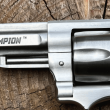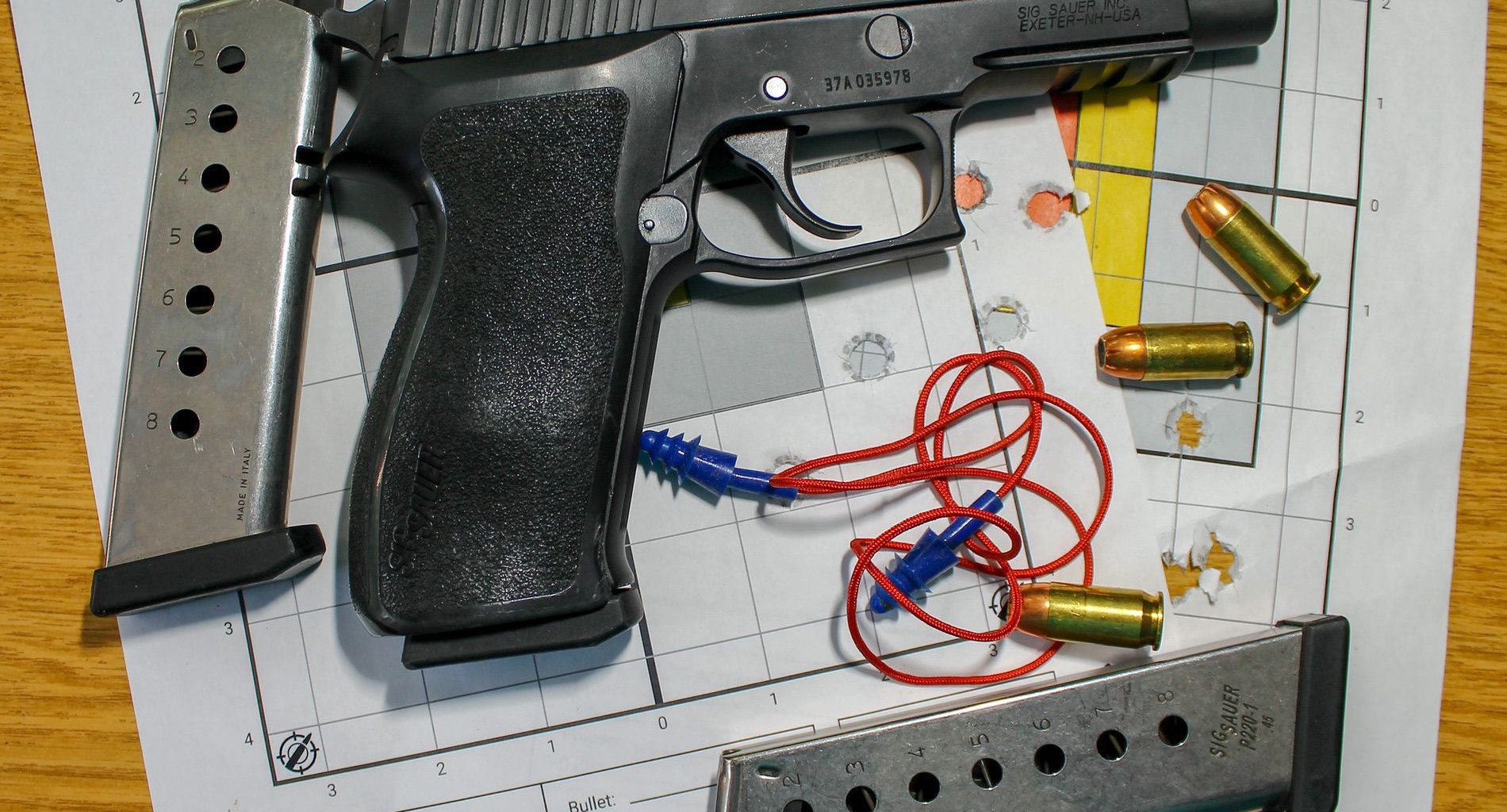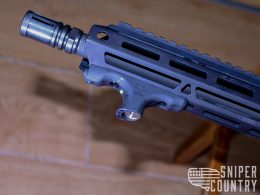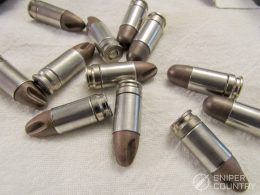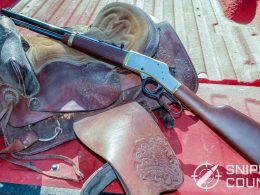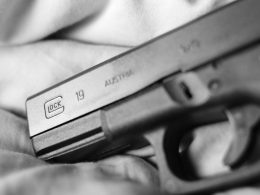The SIG Sauer P220 is one heck of a gun. Police agencies across the U.S. and around the world have used, and still use, Sig pistols extensively. Matter of fact, one very close-to-me state issues the 220 to its state troopers and also issues the P365 as a backup gun. I’ll get more into this aspect a little later…suffice it to say that the old .45 is far from dead. It is alive and well and this gun has a lot to do with that.
A Bit of History
Where did the Sig P220 come from, and when was it introduced? Let’s take a quick look at its history…
Quick answer: It was introduced in 1975 by the SIG Arms AG division of Schweizerische Industrie Gesellschaft (now SIG Holding AG), and produced by J. P. Sauer & Sohn, in Eckernförde. It was a very popular model with police and military agencies for many years. But, all good things must come to an end, eh…it was announced in 2019 that the plain-jane P220, along with several other Sig pistols, were being discontinued. Evidently Sig felt that the day of the metal-framed, hammer-fired pistol was done. But, you can still find them for sale and police trade-ins abound. Plus, Sig still makes the Legion versions of the gun.
Longer version: Sig designed the gun for the Swiss army to replace their Sig P210s. The year was 1975. Sig partnered with J. P. Sauer to help produce the pistol for commercial production and distribution. The gun was adopted by the Swiss army in 1975 as the “Pistole 75â€, in 9mm chambering. It was soon followed by the P226 which utilized a double-stack magazine. Here are a couple of interesting side notes… from 1977-1980, this gun was sold in the U.S. as the Browning BDA – I remember when that came out. It created quite a splash, as it was unlike most American guns out at that time. Also, I was surprised a bit to learn that Swiss army personnel (in particular officers and enlisted personnel of the medical corps) can buy their issued sidearm with an administrative payment of 30 francs – that’s an easy way to retain use of your pistol, for sure. Of course, this practice has been followed for years by the Swiss. Every “fit†male in Switzerland spends time in the military, and then when mustered out has the option of buying their service weapon. Militia members in that country keep their weapons at home. Talk about gun ownership – this is one good example. At any rate, the P220 was a new design.
BONUS OFFER: Get your free shooting range targets to print at home!
Get your free targets to print at home!
Design Notes
The P220 was the first pistol, to my knowledge, to have the barrel lock to the slide via the oversized barrel chamber’s top edge mating with the slide’s ejection port. This is a common style of manufacture today, but it was new back then. The then-popular method of barrel lock-up was the Browning tilt-barrel system with milled locking lugs and grooves in in the barrel and top of the slide as in the 1911, Hi-Power and CZ-75. The new P220 did away with those, and locked the squared-off chamber against the ejection port. (Here is a good animation of the Browning system in action). The new system allowed barrels and slides to be made with no lugs or grooves, thereby simplifying the manufacturing process a bit.Â
Another feature is the decocking lever. A lot of DA/SA pistols have this feature. It is one of four safeties on this pistol. The “Four-Point Safety System†consists of (1) a patented automatic firing pin block, (2) a decocking lever, (3) a safety intercept notch on the hammer, and (4) a trigger bar disconnector. So, you can pretty well carry this gun with a round in the chamber and feel safe. For more on this 4-point system, go here. In terms of something a bit different with regards to Sig pistol actions, I reviewed a while back another Sig pistol, a P226. It used a different type of action – the Double Action Kellerman system (DAK). To read about that variation, check my review out. It is an interesting deviation from the decocking-lever-equipped Sigs.
Now, we’ll look at the specifications of my test gun. Some of these come from Sig’s website while others come from my measurements.Â
| Caliber: | .45 ACP |
| Length: | 7.7†|
| Width: | 1.3“ (measured across widest part) |
| Height: | 5.5†|
| Weight: | 29.8 oz. (weighed on my digital scale) |
| Sight Radius: | 6.3†|
| Rail: | SIG Rail |
| Action: | DA/SA, Single-Stack |
| Trigger: | Standard Curved |
| Trigger Pull Weights: | DA: 8 lbs., 0 oz.; SA, 2 lbs., 4 oz. (measured with my Lyman trigger pull gauge) |
| Magazines: | 8-round Steel Mag, 2 included |
| Sights: | SIGLITE Night Sights |
| Barrel: | Carbon Steel |
| Frame: | Alloy, Hard Coat Anodized |
| Slide: | Stainless Steel, Nitron |
| MSRP: | The P220 has been discontinued except for the Legion series, so no MSRP is available |
| “Real World†Price: | $1100 - $1400. Police trade-ins are available, as well – these guns are usually excellent buys |
BONUS OFFER: Get your free shooting range targets to print at home!
Get your free targets to print at home!
Photo Gallery
Here are some shots of the gun I was loaned…
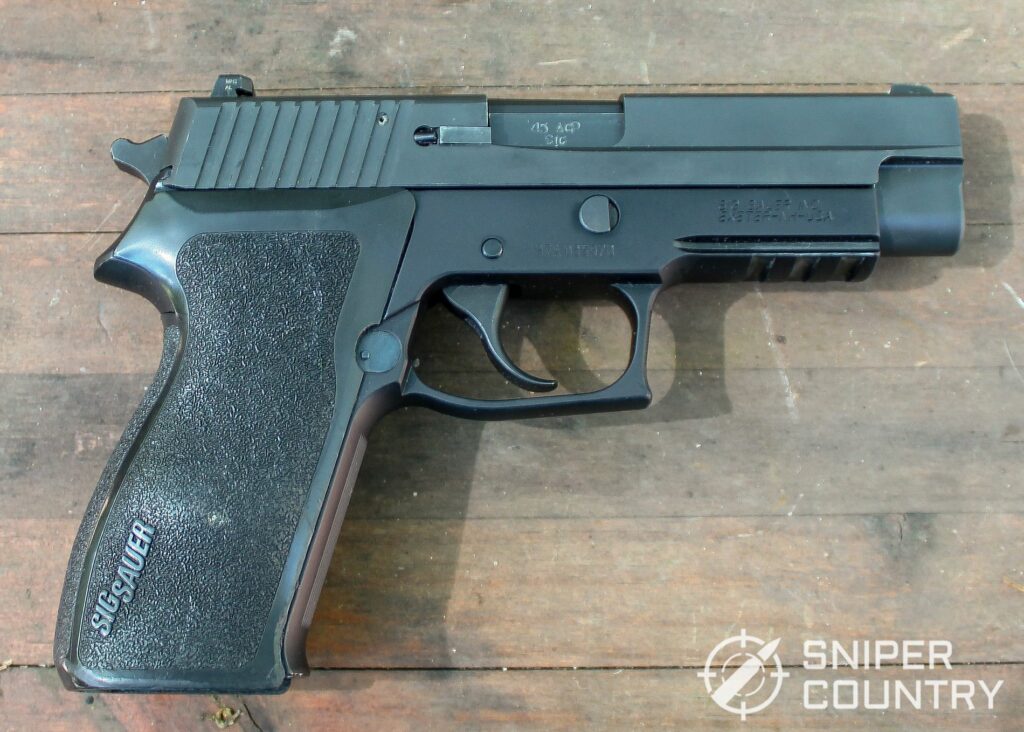
Mug shots…
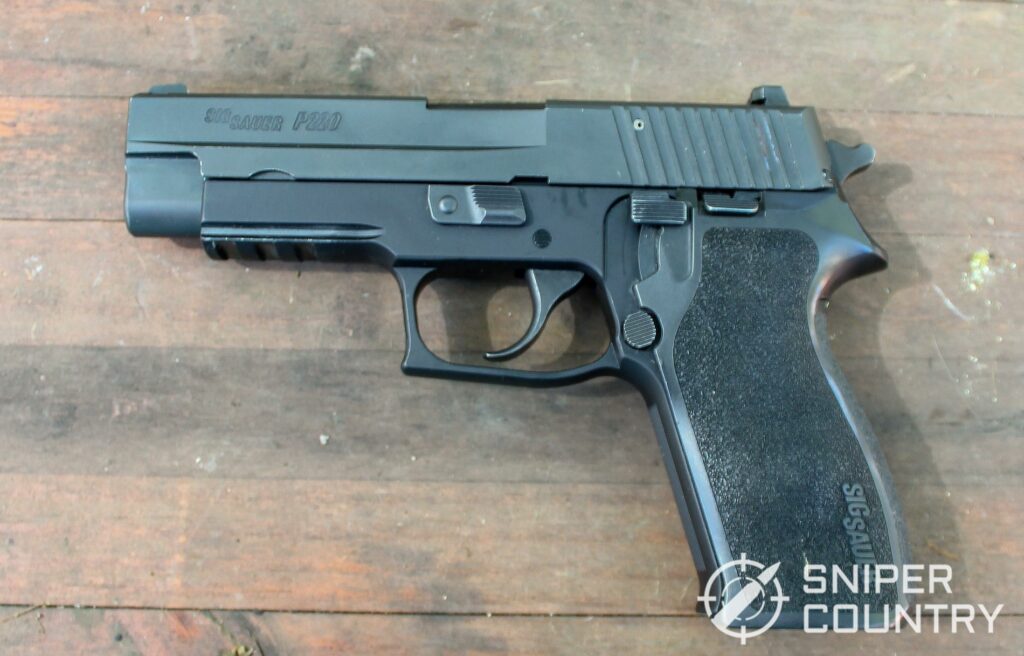
Since the frame is metal, the grip panels are replaceable.Â
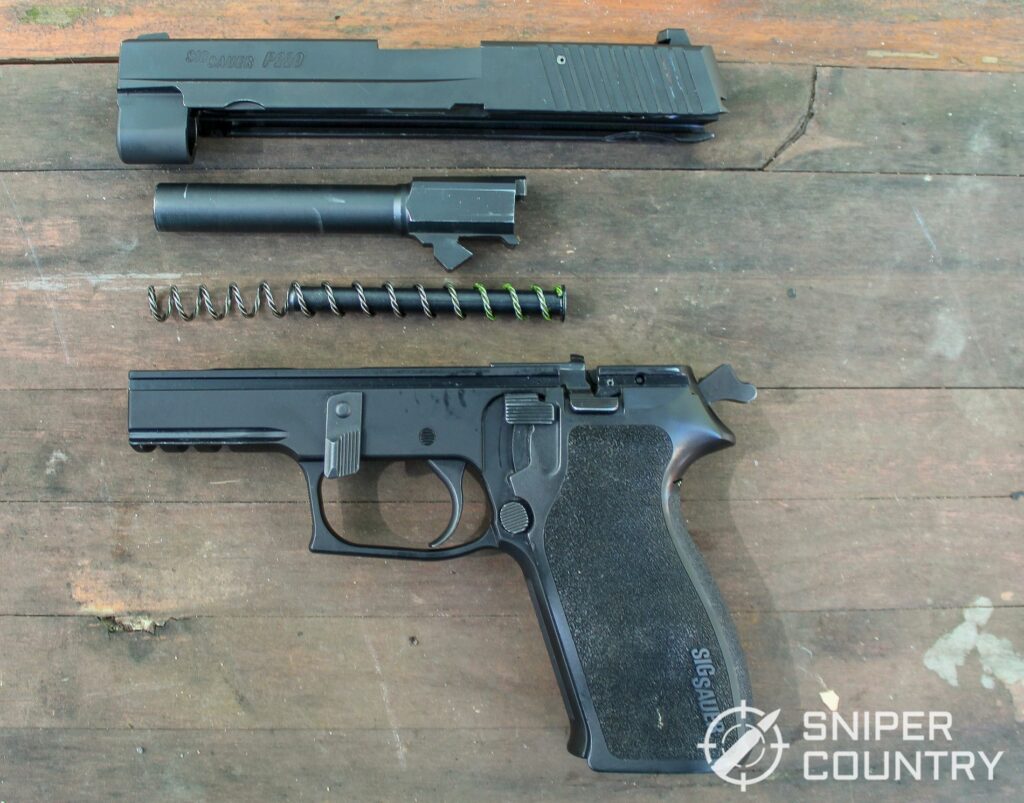
Here’s a quick note on taking the gun apart to clean it…
First, remove the magazine and make sure the gun is empty. Then, pull the slide back and lock it. Swing the takedown lever down and pull the slide off the front of the frame. Remove the recoil spring and barrel. That’s it – reverse to put it back together. Just lock the slide back again before you attempt to rotate the takedown lever.
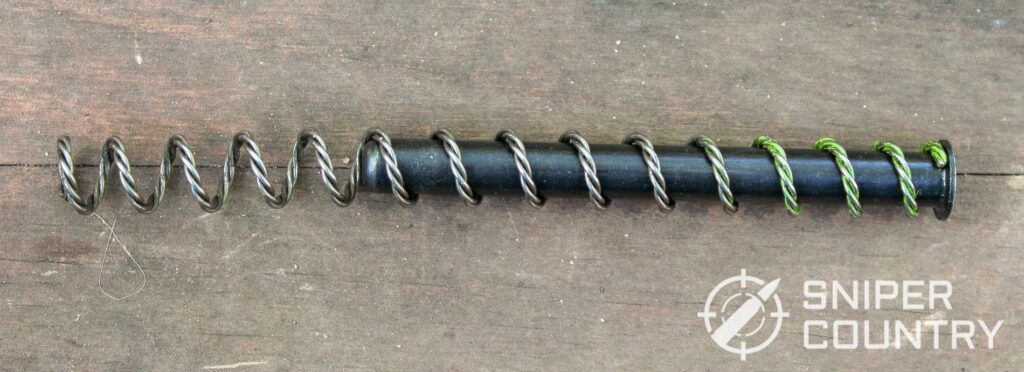
Recoil spring and guide. You get three springs for the price of one… it does help dampen recoil.
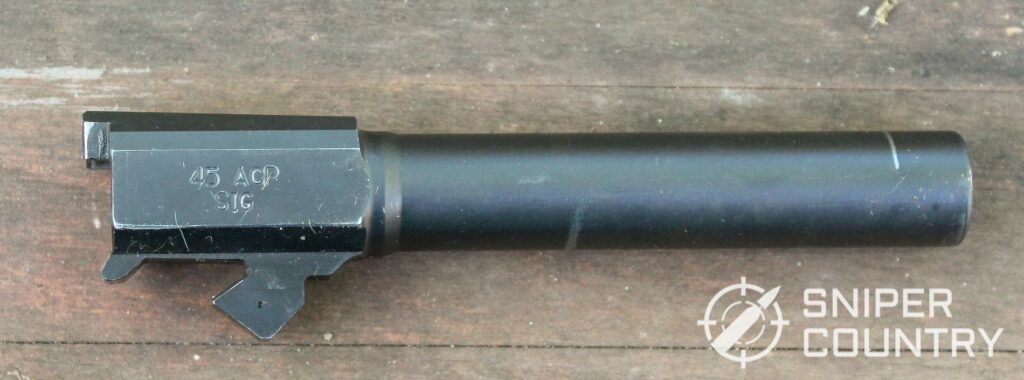
Barrel and feed ramp.
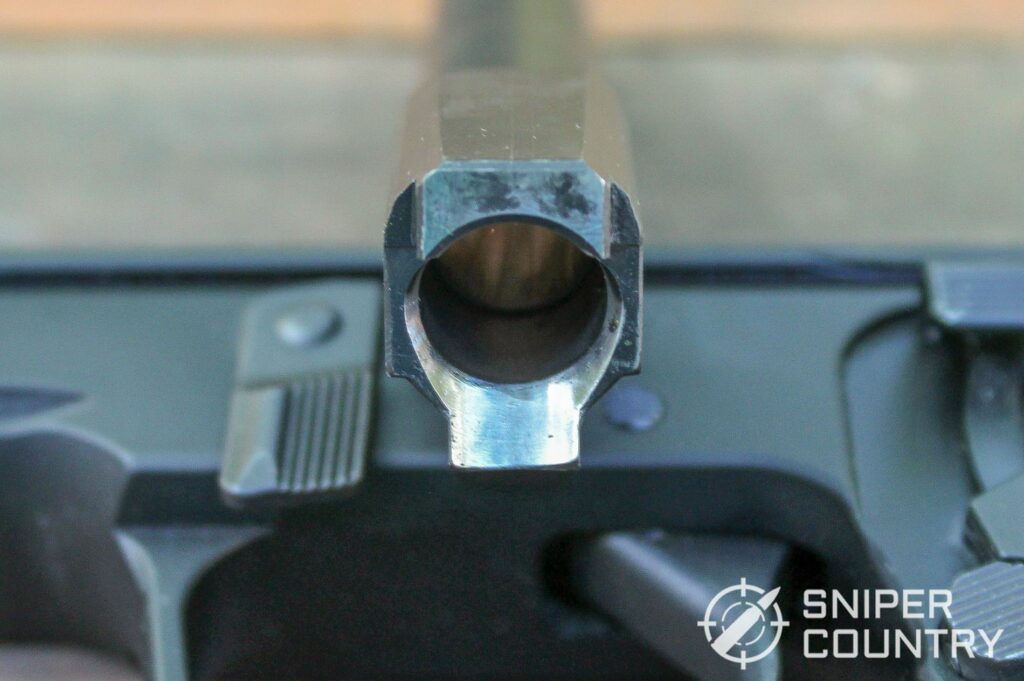
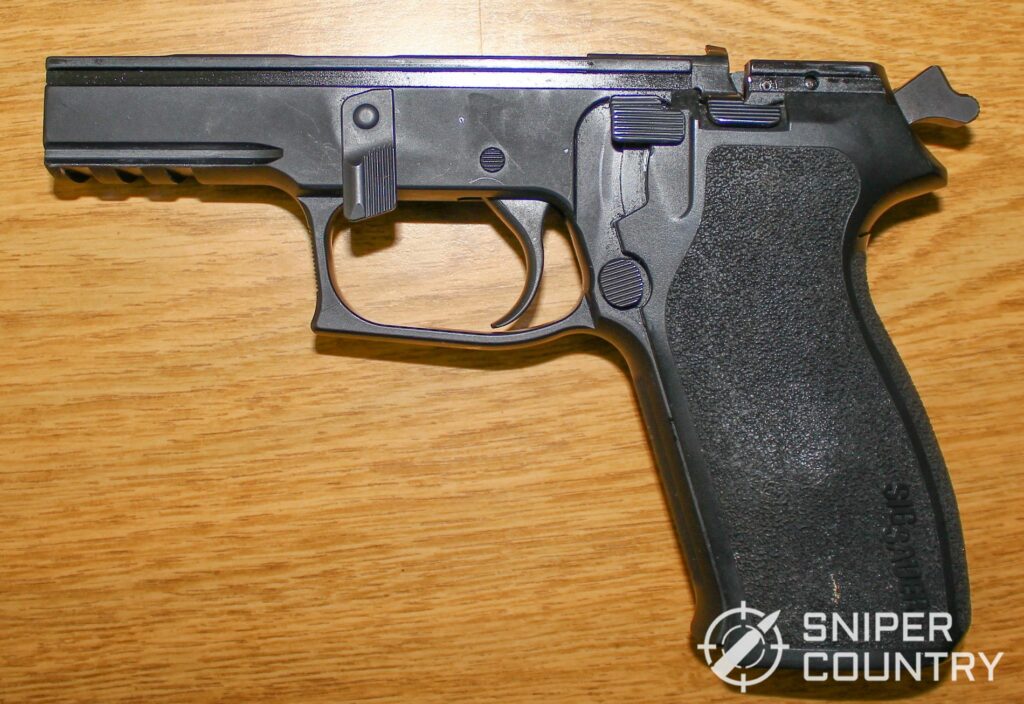
Frame, left side…note the levers: L-R, takedown, decocker, slide release.
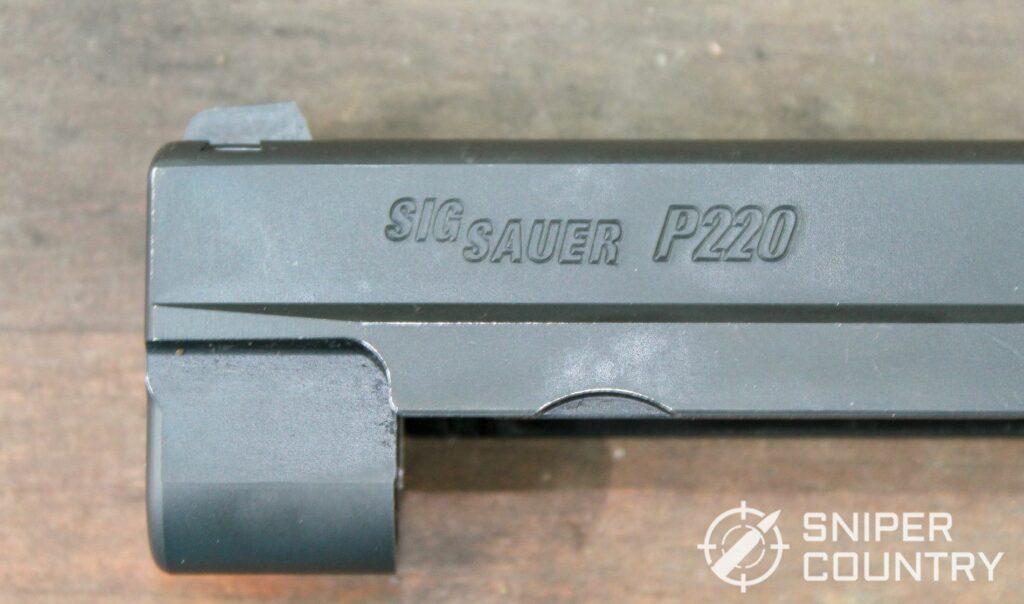

Slide, underneath – very clean, except for normal wear.
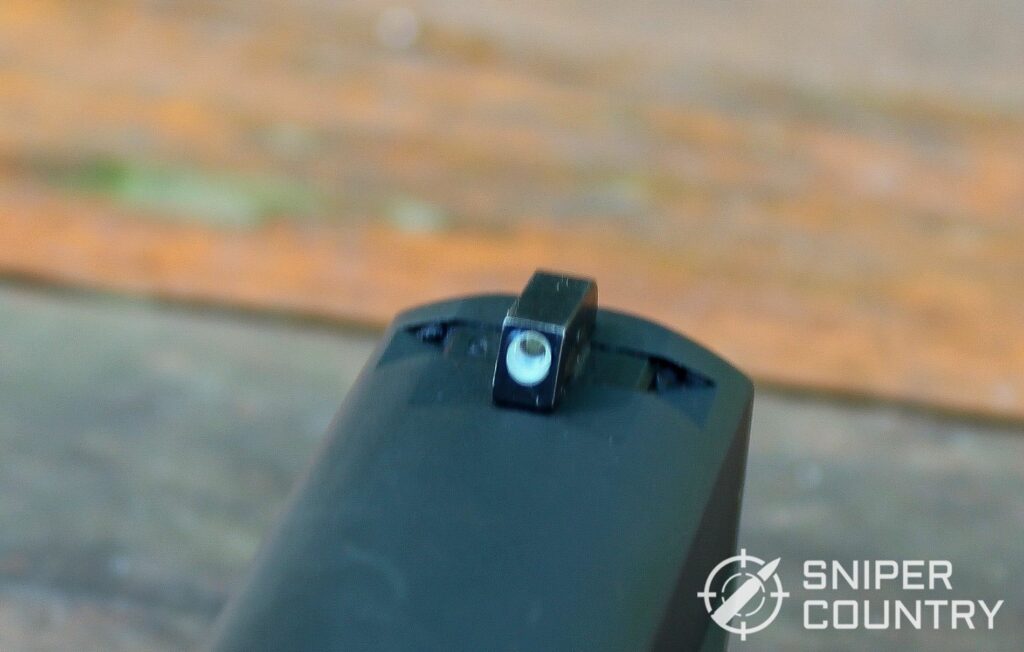
Sights, front and rear, and adjustment screw…these are night sights and they do still glow in the dark.
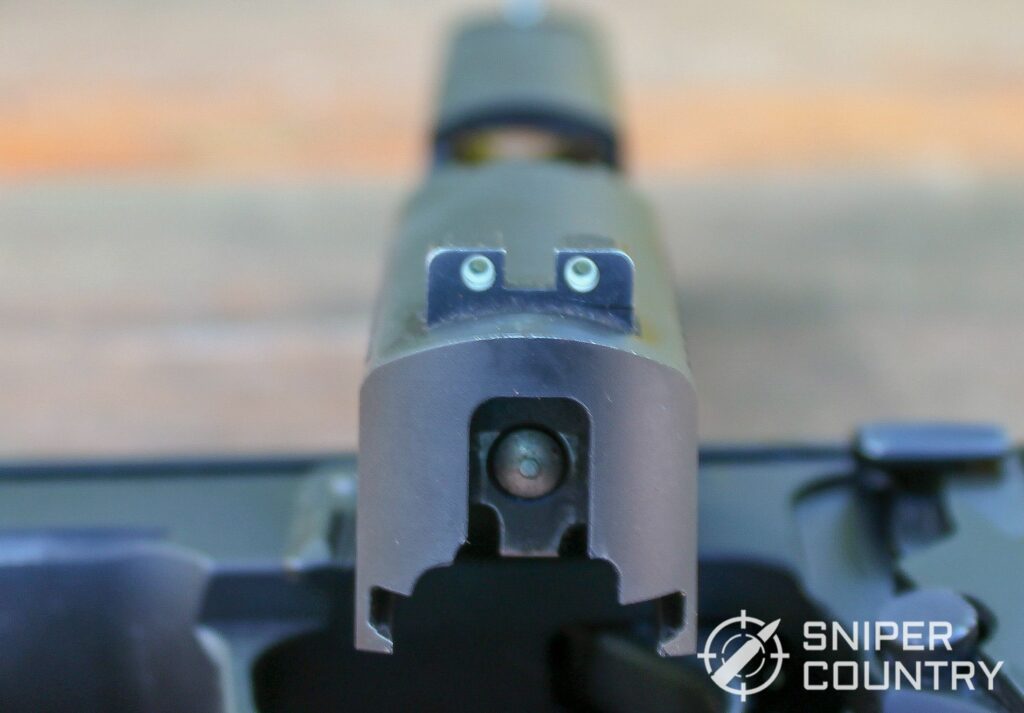
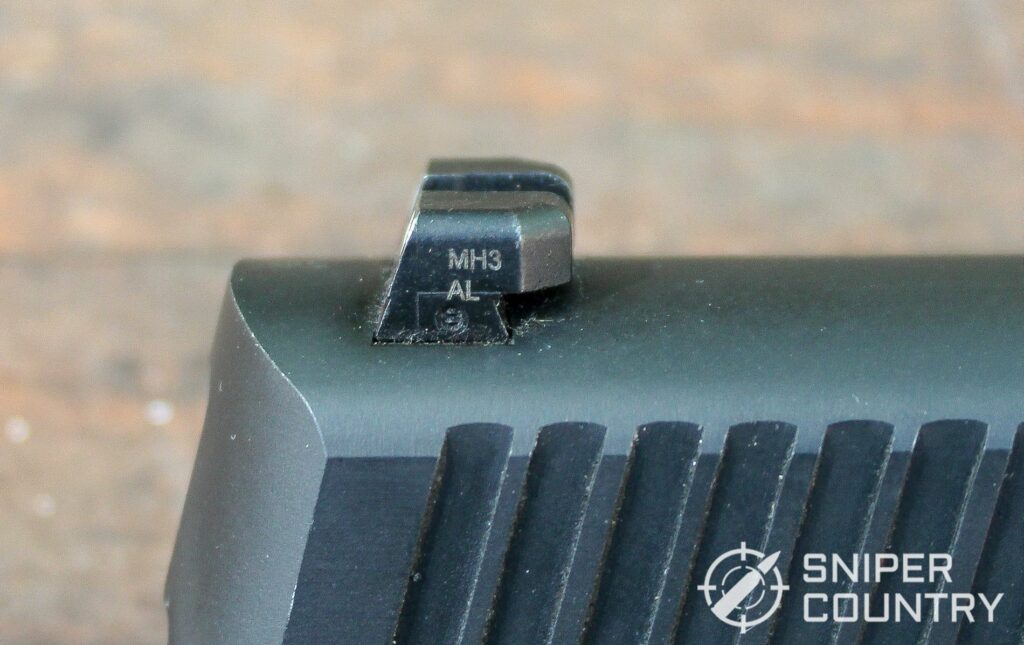
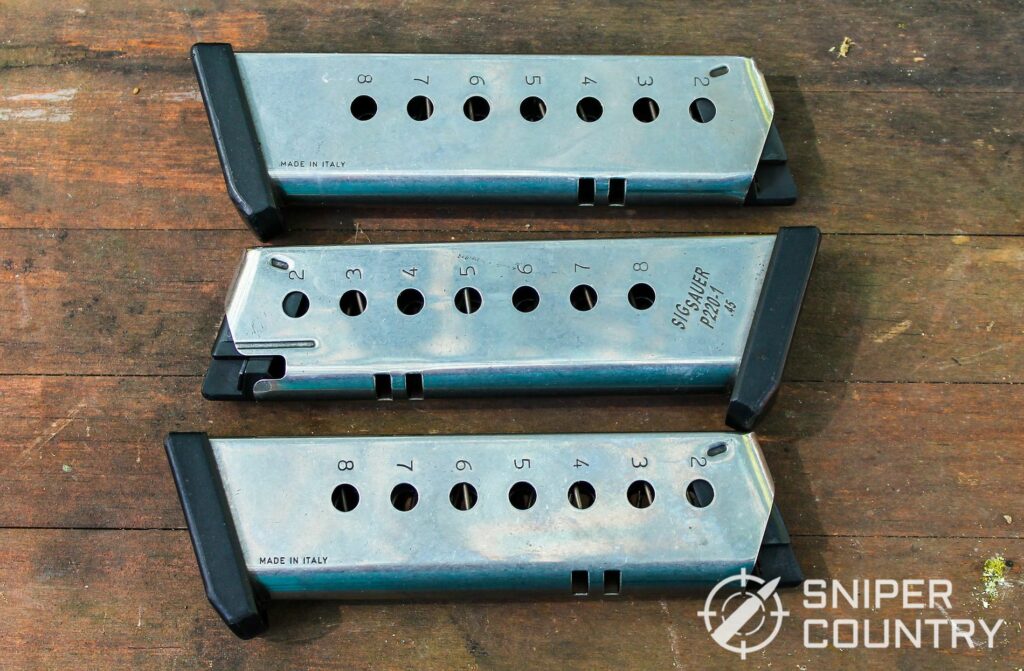
Magazines. Two are included with the gun. Note the stamping – Made in Italy… Mec Gar?
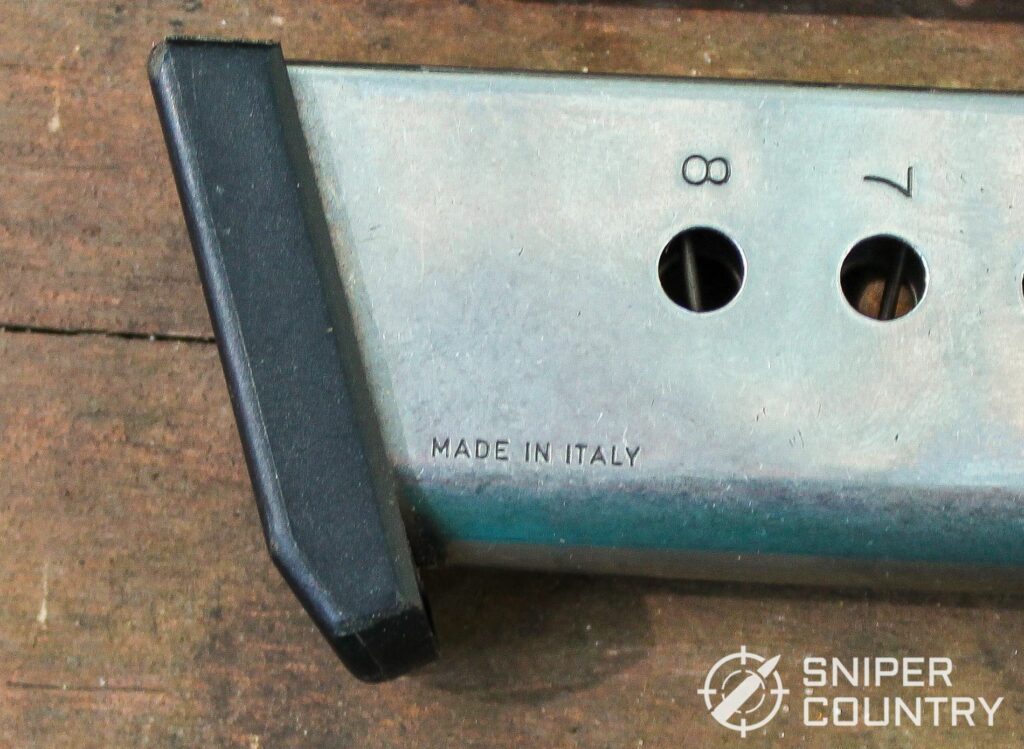
BONUS OFFER: Get your free shooting range targets to print at home!
Get your free targets to print at home!
Shooting The P220
I shot the P220 with three different loads, two factory and one handload. I have to admit right up front that my ammo situation is getting a bit tenuous… you can’t find most common calibers of ammo anywhere around where I live, and even online resources are a bit sketchy as well. I was glad that Fiocchi had sent ammo before for me to review, as I still have some of that left – that was what I shot. Notice there are only two targets here – my handload performed abysmally. I shot a plain-jane 200-grain cast SWC over 5.3 grains of HP-38 (same as Win. 231) which is a typical go-to target load for me. The bullets looked like they keyholed – I have never had that happen with that load in ANY .45 I’d shot them in. At any rate, there is not a photo of that target. Not sure what happened, but I at least had the other two loads’ bullets go through the targets nose-first as designed.
You also can see where my shots printed – low and right – but that’s a sight issue and since it isn’t my gun, I don’t care. At least most of the rounds clustered somewhat together. Every Sig pistol I’ve shot has shown at least better-than-average accuracy and this one would be no exception if I had plenty of ammo and could really wring it out. I’m afraid my reviews of late (and probably future ones, too, for that matter) will be lacking in the target-photo area if I don’t have ammo to shoot. But, I know I’m not alone in that boat.Â
At any rate, these were shot at around 20 yards, at my backyard range. Although not exactly Camp-Perry-worthy, they’ll do until I get more shots downrange from this gun (which won’t happen right now). Rest assured, if you end up with a Sig of any model, you won’t have to worry about accuracy. After all, I’ve talked with a friend who is a member of a nearby state police department (which issues P220s) who has shot it in qualification – if the guns were inaccurate, they would’ve been sold off. That reminds me of something he told me. When the Sigs were new to the troopers, he said many of the shooters accidentally dropped the mag from the gun when they brushed against (and accidentally pressed) the mag release button. They would fire one shot then have the gun lock open or not return to battery as the magazine either fell out or came unseated. He thinks that they were not used to this button, and how far out it sat. I had no trouble with that, but I’m left-handed. At any rate, once they figured out what was going on, they resolved the issue and now they carry the gun daily.
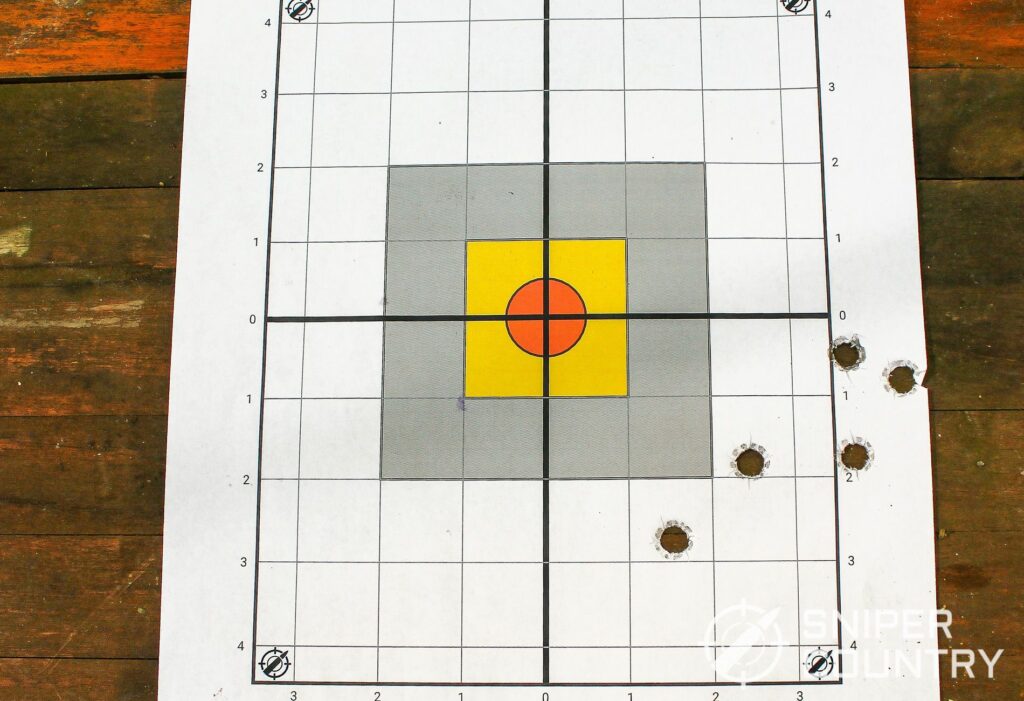
200-grain JHP
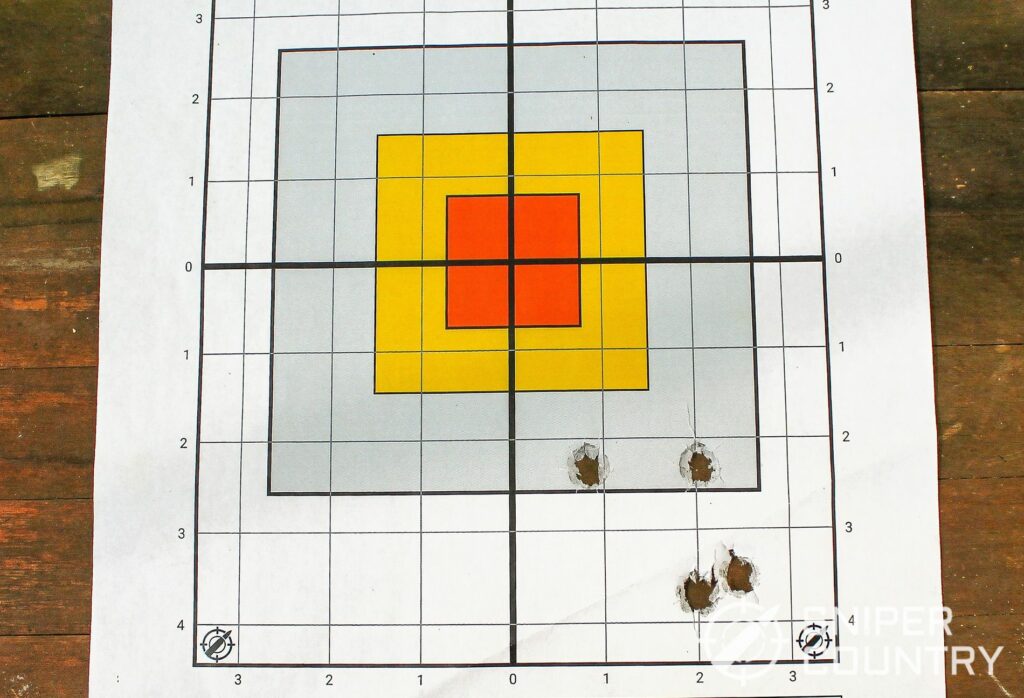
230-grain RN FMJ
In Summary…
I have always had a great deal of respect for European guns. Guns made by Sig Sauer, Walther and H&K have always placed high in my estimation. Now the relative late-comer Glock is added to mix, as well. I just reviewed a Walther PPQ and really liked it. I commented in that piece that I missed the first-generation magazine release that Walther used when the PPQ first came out – the paddle release at the base of the trigger guard. That company and H&K used that release a lot until American shooters complained. So, they changed the paddle release to a button behind the trigger guard. I for one, however, liked it because it was ambidextrous. I didn’t have to move a button to the right side of the frame – I just pressed the little lever down. Why do I mention this, when we’re talking about a gun that uses the traditional button? Because I am a fan of European gun engineering. I do guess I should mention, in fairness, that when Sig brought out the P220 initially in 1975, it had the heel-style European magazine release. They changed it to the familiar button-type release fairly quickly but I thought I ought to at least mention that. I do not like heel-type releases. So, I guess I’m selective in my admiration of some European gun features but all in all I think they do a pretty good job. And now, in this modern age, many of those guns made for the American market that were formerly manufactured in Germany, Switzerland, the Czech Republic, etc. are now made in the U.S. in subsidiary factories. The SIGARMS factory in Exeter, New Hampshire is that company’s entry in the made-in-the-USA factory market.Â
Do I like the P220? Certainly. After all, I’m a fan of the .45 ACP, the “punkin ball†of pistol calibers. Would I carry one? Not unless it was in an OWB holster – I’m not tall or thin enough to pull off carrying a full-size gun. Would I use one for home defense? Of course – why not? That pistol, a flashlight and a couple of extra mags near the bed would be a good thing, especially given the fact that the sights included on the gun are of the night variety. What do you get if you buy one of these? You would get Sig reliability and reputation – after all, not only do police agencies use Sigs, but so does the U.S. military among others. That’s a pretty good recommendation. You also get a well-made pistol that will fire every time you want it to. Even if you buy a police trade-in, you are guaranteed that the gun has been maintained, cleaned often and has proven itself on the qualification line.Â
The P220 has long been a favorite of law enforcement and military buyers – if you’re looking for a DA/SA gun with a decocker, you might want to check this one out. Let me know below if you own one and what you think of it. As always, keep ‘em in the black and stay safe!

